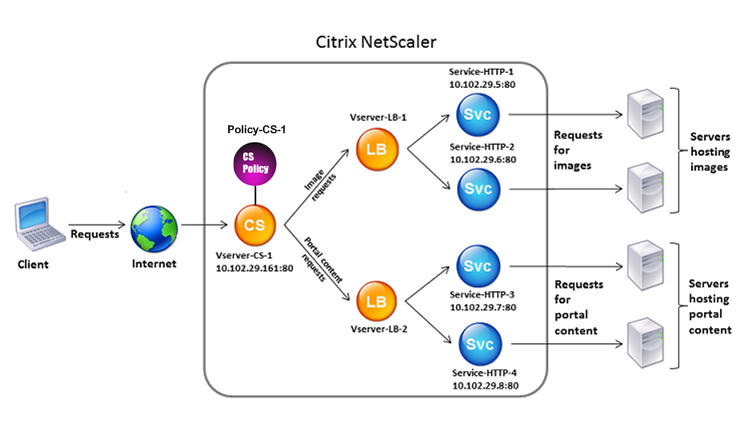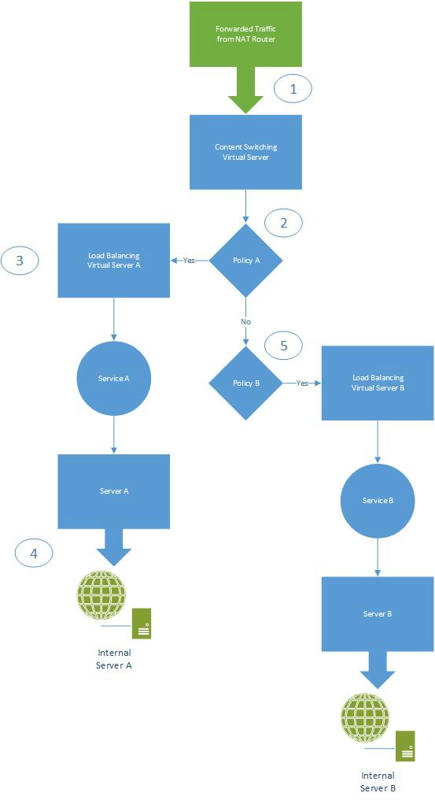Content Switching
Website Visitors:In today’s complex Web sites, you may want to present different content to different users. For example, you may want to allow users from the IP range of a customer or partner to have access to a special Web portal. You may want to present content relevant to a specific geographical area to users from that area. You may want to present content in different languages to the speakers of those languages. You may want to present content tailored to specific devices, such as smartphones, to those who use the devices. The Citrix NetScaler content switching feature enables the NetScaler appliance to distribute client requests across multiple servers on the basis of specific content that you wish to present to those users.
To configure content switching, first create a basic content switching setup, and then customize it to meet your needs. This entails enabling the content switching feature, setting up load balancing for the server or servers that host each version of the content that is being switched, creating a content switching virtual server, creating policies to choose which requests are directed to which load balancing virtual server, and binding the policies to the content switching virtual server. You can then customize the setup to meet your needs by setting precedence for your policies, protecting your setup by configuring a backup virtual server, and improving the performance of your setup by redirecting requests to a cache.
How Content Switching Works
Content Switching enables the NetScaler appliance to direct requests sent to the same Web host to different servers with different content. For example, you can configure the appliance to direct requests for dynamic content (such as URLs with a suffix of .asp, .dll, or .exe) to one server and requests for static content to another server. You can configure the appliance to perform content switching based on TCP/IP headers and payload.
You can also use content switching to configure the appliance to redirect requests to different servers with different content on the basis of various client attributes. Some of those client attributes are:
- Device Type. The appliance examines the user agent or custom HTTP header in the client request for the type of device from which the request originated. Based on the device type, it directs the request to a specific Web server. For example, if the request came from a cell phone, the request is directed to a server that is capable of serving content that the user can view on his or her cell phone. A request from a computer is directed to a different server that is capable of serving content designed for a computer screen.
- Language. The appliance examines the Accept-Language HTTP header in the client request and determines the language used by the client’s browser. The appliance then sends the request to a server that serves content in that language. For example, using content switching based on language, the appliance can send someone whose browser is configured to request content in French to a server with the French version of a newspaper. It can send someone else whose browser is configured to request content in English to a server with the English version.
- Cookie. The appliance examines the HTTP request headers for a cookie that the server set previously. If it finds the cookie, it directs requests to the appropriate server, which hosts custom content. For example, if a cookie is found that indicates that the client is a member of a customer loyalty program, the request is directed to a faster server or one with special content. If it does not find a cookie, or if the cookie indicates that the user is not a member, the request is directed to a server for the general public.
- HTTP Method. The appliance examines the HTTP header for the method used, and sends the client request to the right server. For example, GET requests for images can be directed to an image server, while POST requests can be directed to a faster server that handles dynamic content.
- Layer 3/4 Data. The appliance examines requests for the source or destination IP, source or destination port, or any other information present in the TCP or UDP headers, and directs the client request to the right server. For example, requests from source IPs that belong to customers can be directed to a custom web portal on a faster server, or one with special content.
A typical content switching deployment consists of the entities described in the following diagram.

A content switching configuration consists of a content switching virtual server, a load balancing setup consisting of load balancing virtual servers and services, and content switching policies. To configure content switching, you must configure a content switching virtual server and associate it with policies and load balancing virtual servers. This process creates a content group—a group of all virtual servers and policies involved in a particular content switching configuration.
Content switching can be used with HTTP, HTTPS, TCP, and UDP connections. For HTTPS, you must enable SSL Offload.
When a request reaches the content switching virtual server, the virtual server applies the associated content switching policies to that request. The priority of the policy defines the order in which the policies bound to the content switching virtual server are evaluated. If you are using default syntax policies, when you bind a policy to the content switching virtual server, you must assign a priority to that policy. If you are using NetScaler classic policies, you can assign a priority to your policies, but are not required to do so. If you assign priorities, the policies are evaluated in the order that you set. If you do not, the NetScaler appliance evaluates your policies in the order in which they were created.
In addition to configuring policy priorities, you can manipulate the order of policy evaluation by using Goto expressions and policy bank invocations. For more details about default syntax policy configuration, see “Configuring Default Syntax Policies.”
After it evaluates the policies, the content switching virtual server routes the request to the appropriate load balancing virtual server, which sends it to the appropriate service.
Content switching virtual servers can only send requests to other virtual servers. If you are using an external load balancer, you must create a load balancing virtual server for it and bind its virtual server as a service to the content switching virtual server.
Posted in Citrix eDocs
Pictorial representation of content switching:

- An external request is received by the NetScaler on the IP and Port configured as a Content Switching virtual server.
- The NetScaler inspects the traffic and if it matches a policy rule, forwards the traffic to the target configured for the rule.
- The target Load Balancing server accepts the traffic, passing it along to the server+service specified.
- The internal server receives a request as if it were being originated from the NetScaler’s Subnet IP.
- If the first policy rule didn’t match, subsequent policy rules are evaluated, sending traffic to targets at the first match. If no policy rules match, a default target may be configured; otherwise, traffic is discarded.
Posted in blog.millard.org
Want to learn more on Citrix Automations and solutions???
Subscribe to get our latest content by email.